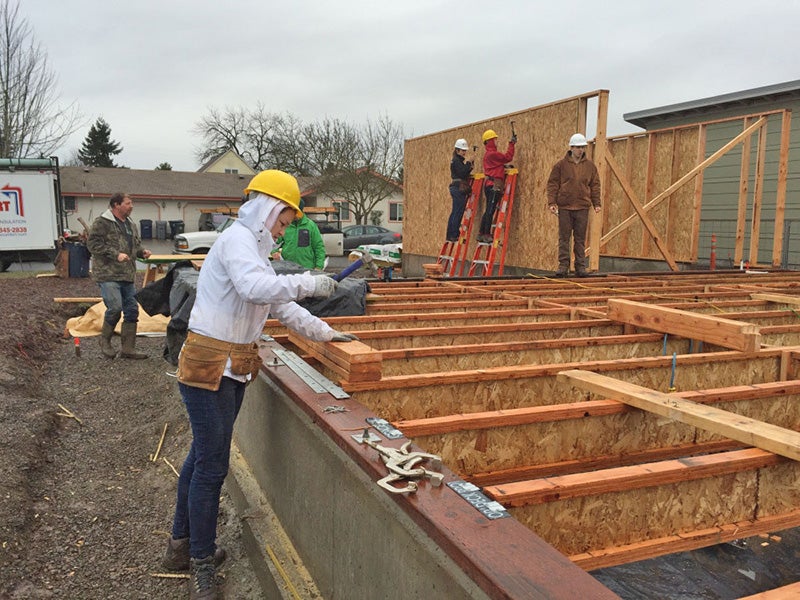The University of Oregon Department of Architecture was recognized in January as among the finest in the country for its housing design education.
UO architecture faculty members Michael Fifield, Peter Keyes, and Rob Thallon, who spearhead the University of Oregon Housing Specialization Program, received the “Housing Design Education Award-Excellence in Housing Education Course or Activity.” The accolade is given jointly by Association of Collegiate Schools of Architecture (ACSA) and the American Institute of Architecture (AIA).
The award “recognizes the importance of good education in housing design to produce architects ready for practice in a wide range of areas and able to be capable leaders and contributors to their communities,” the ACSA website states.

Above: Students finish floor joists during the OregonBILDS studio in January 2016 in west Eugene. “Very few other—if any—housing programs address housing design education in a comprehensive manner,” says Professor Michael Fifield. This is the third house UO students have built during the OregonBILDS program. Photos courtesy OregonBILDS.
The three professors oversee a variety of subject-specific courses. Associate Professor Thallon teaches Design Build and Residential Building Construction courses, including Oregon BILDS (Building Integrated Livable Designs Sustainably); Associate Professor Keyes instructs a thesis studio and a Housing Design course; and Professor Fifield, the program’s director, teaches housing design studios and subject-area courses including Housing Prototypes, Community Design, and Minimal Dwelling.
This thorough arrangement of standardized studios on housing design typologies prompted the ACSA to recognize the program.
“Very few other—if any—housing programs address housing design education in a comprehensive manner,” says Fifield, whom ACSA recognized as a Distinguished Professor in 2015. “And there are very few other programs. Most schools offer housing studios and a course, but few have programs.”
In their application for the award, the professors wrote that meaningful housing design education requires a standardized prescription of courses—as opposed to more sporadic offerings—as well as research opportunities for faculty and students and professional involvement and mentoring within these classes.
Many of the courses are open to students in other disciplines rather than being limited to undergraduate and graduate students in architecture.
The program’s two core courses—Housing Prototypes and Housing Design—provide overviews to common housing design issues. Community Design examines smart growth and alternatives to urban sprawl, while Minimal Design looks at how small-scale living situations can be conducive to improved energy efficiency, sustainability, affordability, and residential construction.
The program offers a two-term thesis studio on housing each year. Boot Camp Housing Studio gets its name for the intensity of the curriculum, which assigns numerous short projects, each on a different housing type.
“The combination of the course offerings on a regular basis in subject-area courses, housing studios, design-build, as well as programs for both students and the primary faculty involved—that we feel is unique,” says Fifield.

Above: With the subfloor completed, students in the OregonBILDS studio frame and lift exterior walls into place. The BILDS house will be sold to an income-qualified family.
The program’s electives have included Affordable Housing, Site Planning for Cluster Housing, Real Estate Development, Post-Occupancy Evaluation, Intentional Communities, and various history of housing courses that focus on a specific architect or location.
The award application noted these benefits, among others, that the program provides:
• Placement after Graduation: Students are assisted in placement in offices that specialize in housing. Two students in the past ten years have gone on to become Rose Fellows and work in affordable housing.
• Research: Faculty members doing funded, and non-funded, research hire students in the housing program as research assistants.
• Funding and Studio Support: Nationally recognized firms have provided financial support for student and faculty travel, consultants for studios, and guest lecturers on housing.
• Visiting Faculty: Nationally known housing designers teach a studio and subject-area course one term during the year.
• Relationship to Local Constituencies: The program has a strong relationship with local municipalities and affordable housing agencies in regard to housing matters.
Fifield says he and the other professors hope to expand the housing program’s courses to feature Affordable Housing Policy, Residential Real Estate Development, and History of Housing. While the topics are included in the current curriculum, Fifield says, more specialized courses would provide a greater emphasis.
He adds that the program also hopes to eventually tap into UO President Michael Schill’s background in real estate and housing.
Fifield and Keyes will attend the ACSA national conference and award ceremony in Seattle in mid-March, where they will present the housing program during a session and accept the Housing Design Education Award on behalf of the program.
